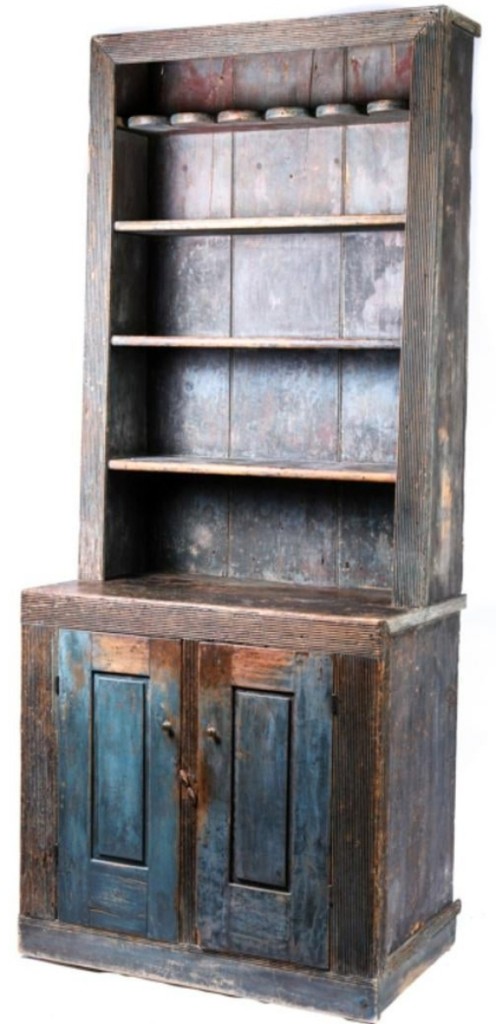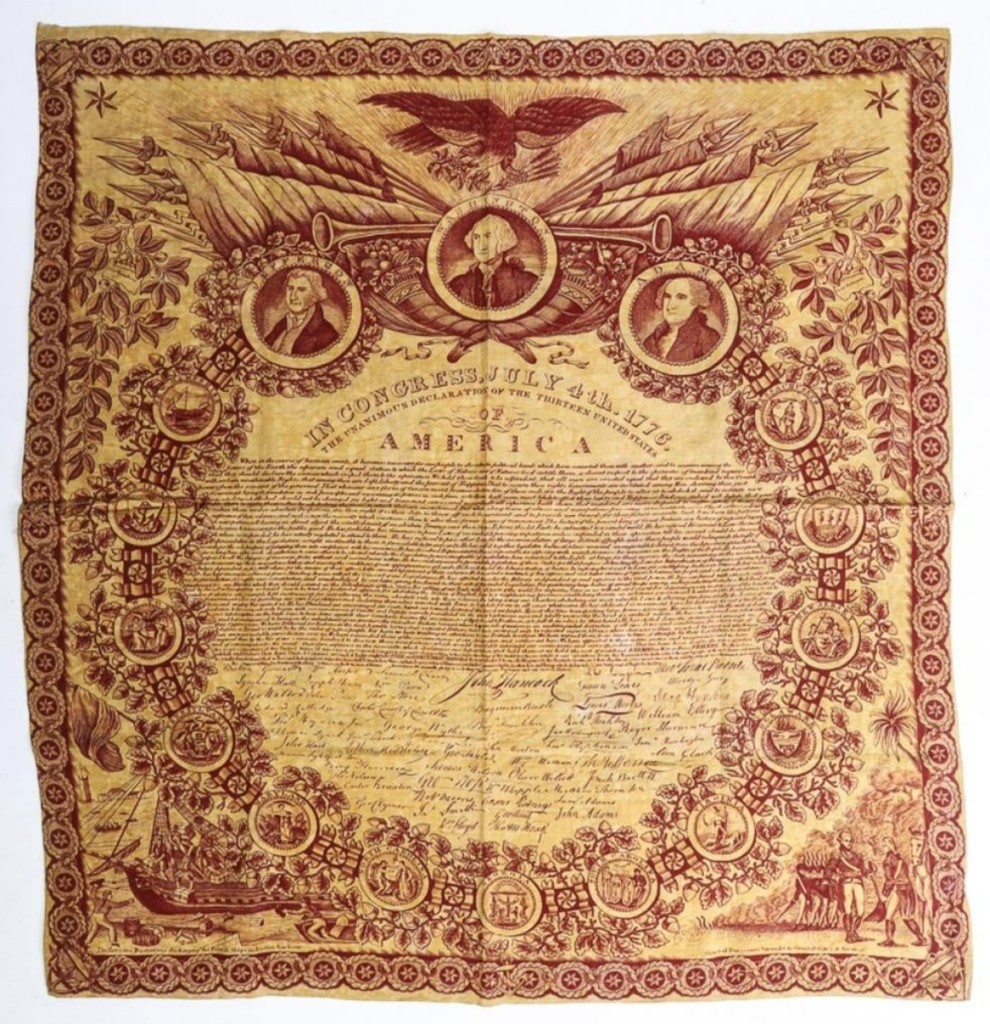
Bringing the highest price of the two-day sale, $38,350, was this Simon Willard tall case clock. The dial was painted “Warranted for Capt. John Brown,” along with Willard’s name.
Review and Onsite Photos by Rick Russack, Additional Photos Courtesy of John McInnis Auctioneers
AMESBURY, MASS. – There were plenty of photos online. Should I go to the preview? The answer, at least for this auction, was definitely yes. There was a ton of quality and interesting stuff both days at John McInnis’ January 3-4 sale, and you really had to be there. It was the only way to see it all and really compare, for example, one grain painted piece of furniture to another, or one tall case clock to another, or one lot of Rose Mandarin porcelain to another. Several people at the preview commented that they were glad they had decided to take a look for themselves, and this was in spite of the fact that, as Dan Meader, gallery director, said, they took close to 14,000 photos for use on the website to illustrate the more than 800 lots.
And you’d probably have seen things you would overlooked just looking online. There were close to a dozen tall case clocks, numerous pieces of Eighteenth and Nineteenth Century furniture – including a card table said to have belonged to Daniel Webster – a collection of pewter, Chinese porcelain, a wide selection of samplers, numerous paintings, ephemera, firearms, grain painted furniture and storage boxes and a whole lot more. McInnis has been turning up lots of good stuff recently.
One of the tall case clocks, made by Simon Willard and marked on the dial “Warranted for Capt. John Brown,” along with Willard’s name, was the highest priced item in the two-day sale, finishing at $38,350. It had a chiming moon phase movement, delicate fretwork, original finials and a surface that may have been original. Brown served in the Revolutionary War, and the clock remained in his family until being consigned to this sale, along with several other items from the family. Another tall case clock, which did not bring as much money, finishing at $1,063, had been made by Joshua Tolford of Maine. It was bought by his great-great-grandson, Timothy Tolford, and his wife, Kathryn, of Falmouth, Maine. They had come specifically for the clock and said that the family believed that only about four tall case clocks had been made by Joshua (this is probably not correct). They own one other, and three clocks he made are owned by other family members. This nice early Federal period example was signed on the dial, retained its original old red surface, finials, fretwork and original works. When asked, Timothy Tolford said, “It was really just luck that we found that McInnis would be selling it. I try to watch for them, but I just happened to be looking on the internet last week and there it was.” Another tall case clock of regional interest was a circa 1785 example made by Timothy Chandler, Concord, N.H., which realized $5,015.
The sale started off strong, with the first lot cataloged as an Eighteenth Century Irish long gun, with Newbury, Mass., provenance, selling for $7,375, well over the estimate. It was a well-worn example and would have been easy to pass by. But it was engraved “Dublin” on the lock plate, “I.M.” on the stock and “Iohn Moody” on the butt plate. The catalog said that a Sgt. John Moody served under the command of Gen. James Wolfe in 1759, when his company fought at the Battle of the Plains of Abraham, where Wolfe was killed.
Hollis Brodrick, a Portsmouth, N.H., dealer known for selling well-researched historical material, bought the gun. He disagreed with the catalog description, saying that the gun actually belonged to the father of the sergeant described above. Brodrick said the gun had several markings indicating its earlier date, including the style of the lettering for the owner’s name and a dragon’s head and serpent included on the butt plate. He said his research indicated the gun had been made between 1695-1715 and actually belonged to a John Moody who lived from the 1660s to 1737, father of the John Moody mentioned in the catalog, who had been born in 1704. He said this research indicated that this is one of the earliest guns that has definite, documented, early American provenance, and added that he was delighted to have bought it.

One of the pleasant surprises of the furniture portion of the sale was this cant back cupboard in old blue. Thought to have been made in Hackensack, N.J., it finished well over the estimate at $8,260.
The sale included other historical material, and two early copies of the Declaration of Independence were among the top prices of the day. An unusually large version, printed on cloth by Robert and Collin Gillespie in 1821, finished at $7,650. The text is surrounded by numerous historical vignettes. According to the website of Dillsburg, Penn., dealer Jeff Bridgman, this is one of the earliest known printings of the Declaration on cloth and was printed in Scotland for the American market. Bridgman’s website – www.jeffbridgman.com – has an extensive description of this item. Another early printing of the Declaration, this one a broadside on paper, printed by Eleazer Huntington, Hartford, Conn., circa 1820-22, sold for $4,720. It’s considered to be one of the earliest broadside printings, following two others done in 1818 and 1819. Prior to these three printings, most Americans had never seen or read the text of the Declaration. The original is now in the Smithsonian in Washington, DC.
A Sheraton mahogany inlaid game table, said to have come from Daniel Webster’s Franklin, N.H., home, sold for $708. A cabinet card photograph of Sitting Bull reached $1,416.
There was a significantly larger historical item sold, but it would be difficult, if not impossible, to display it in a home. It was the third time out for the remarkable (and huge) Columbian cast iron printing press, invented by George Clymer in 1813 and designed to print large documents at a single pass. We say “third time out” because McInnis has sold this press twice before. The first time it brought about $3,000 and the last time it sold for more than $5,000. But moving the approximately 2,000-pound press presented both buyers with the problem of moving it at a reasonable cost. Neither could solve that problem and McInnis permitted them to cancel the transactions. This time it sold for $4,720. The cast iron press is about 6 feet tall and is elaborately decorated with a large spreadwinged eagle and other decorative castings, which were originally gilded. Clymer was American but found his press difficult to sell in the United States and moved to London in 1817, where he was more successful. Not many have survived in America, but one example is in the Museum of Printing in nearby Haverhill, Mass.
Early textiles included two with Marblehead provenance. An Eighteenth Century crewel-work coverlet was embroidered with bands of trees and flowers. It came from the Captain John Brown family, owners of the Simon Willard clock mentioned above. The coverlet sold for $7,080. A sampler from the same family, made by Mary Sparhawk at the age of nine, in 1807, brought $4,720. It depicted a well-dressed man and woman, with a floral border and numerous animals. It was bought by a dealer in the room.
The numerous pieces of early furniture included a cant back cupboard with reeded panels in an original old blue surface. It was believed to have been made in Hackensack, N.J., and sold for $8,260. An Eighteenth Century Chippendale mahogany slant front desk with an elaborate interior, ball and claw feet and a carved drop went out for $1,888. It was believed to have been owned by Franklin Pierce, the 14th US president and the only one from New Hampshire. A Rhode Island Queen Anne tiger maple high chest earned $1,298. A Queen Anne lady’s desk on cabriole legs and trifid feet earned the same amount of money.

The Declaration of Independence, printed on cloth by Robert and Collin Gillespie in 1821, was probably the earliest of the cloth printings. The text is surrounded by numerous historical vignettes and it earned $7,650.
One of the most unusual pieces of furniture was a Boston-made classical mahogany breakfront with entablature that opened to reveal a large pull-down hand-colored map of the United States, published in Philadelphia by S. Augustus Mitchell in 1845. The breakfront had clearly been made to provide storage for the map, and when the map was not on display a viewer would see a normal breakfront with four arched, glazed doors in the top section, over four paneled doors in the base. It sold for $3,245 to an ephemera dealer in the room who said he had bought it only for the map and that he probably would not take the breakfront. The map, he said, was scarce and in fine condition since it spent most of its life rolled up in the special storage compartment. The map was 52 by 66 inches and when on display would hang in front of the breakfront’s top section.
As mentioned earlier, this was a sale where a buyer would definitely have benefited by attending the preview. One of the items that deserved close examination was a folio of maps of China, identified as dating to the first opium war fought between Great Britain and China’s Qing dynasty in 1842. The British, of course, defeated the Chinese and forced a treaty opening more of China’s ports to trade. The folio included a manuscript booklet identifying each of the more than 20 maps and was titled Universal Dominions. Complete Atlas of the Tsing Empire. Each detailed map was hand colored and hand lettered with Chinese characters, although the accompanying booklet was written in English. Why it was made, or by whom, is not known. The folio in which the maps are stored is carved hardwood with dragons and other decorative features. It was bought by a dealer in the room for $2,360. He said that the maps had been sold for $8,000 in a previous sale but had not been paid for. He added that he had been the underbidder at that sale and was quite pleased with this purchase.
The other item that had to be seen to be appreciated was a well-done paper and metallic quillwork and stumpwork floral picture dated 1708. The panel had been set into a later maple Hepplewhite stand from which it could be removed. The difficulty with only seeing it via the many photographs was that many of the decorative details were made of rolled paper cones that were just under a half-inch tall. It was not possible to see the three-dimensional quality in a photograph, so it sold for just $2,242.
It was that kind of a sale. No matter how well cataloged, it was impossible to appreciate it all from either of the two internet platforms in use. After the sale, John McInnis said, “We did about $400,000, and a bunch of people came up to me and said they had a good time. We had a full house both days and people stayed until the end each day. Just a few things were passed, and I don’t expect any problems with getting paid by the internet buyers. We’ve been getting some really great stuff and our next couple of sales should be good ones. This one was a lot of work, but it was worth it. Dan did a great job getting everything ready.”
Prices given include the buyer’s premium as stated by the auction house. For information, www.mcinnisauctions.com or 978-388-0400.




















